Journey Through the Glorious History of Bruges at the Gruuthuse Museum
The restoration of the Gruuthuse Museum in the historic centre of Bruges took five years, but now, the former 15th-century city palace is a unique museum where visitors can discover the city’s rich past through the stories behind more than six hundred objects. Each level recounts the story of a different century, from the flowering of the Burgundian Age to the image of Bruges in the future.
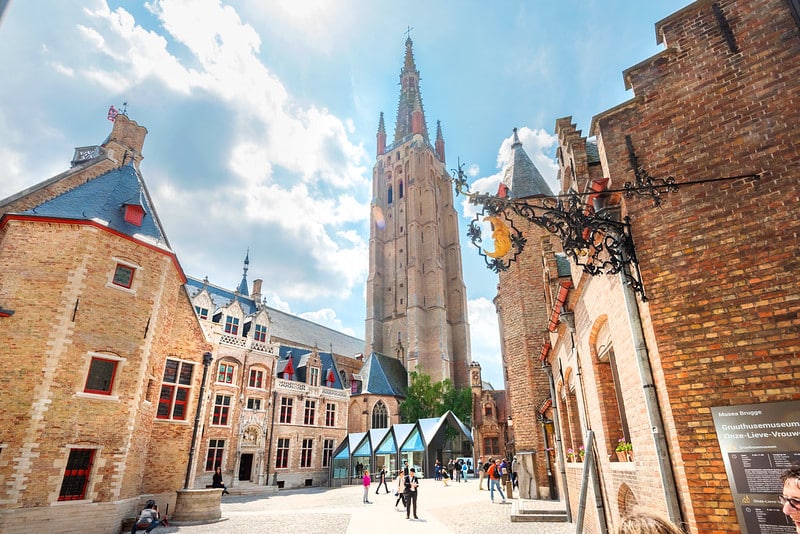 The Gruuthuse Museum and the Church of Our Lady have been restored.
The Gruuthuse Museum and the Church of Our Lady have been restored.© Inge Kinnet / Musea Brugge
Plus est en vous! The motto appropriated by the Jesuits, and which adorned many a school report card, has a history. It was also the motto of one of the most prominent citizens of Bruges in the fifteenth century: Lodewijk (or Louis) of Gruuthuse. After a long restoration, his former home offers visitors a chance to discover how much ‘more’ there is in this museum and its history.
Although access to the museum through a neo-Gothic gate in the courtyard remains unchanged, a glass and steel reception pavilion contrasts vividly with the historic decor. There, it is possible to buy a combination ticket for the museum and the Church of Our Lady, which is just next door and has also been restored to its former grandeur.
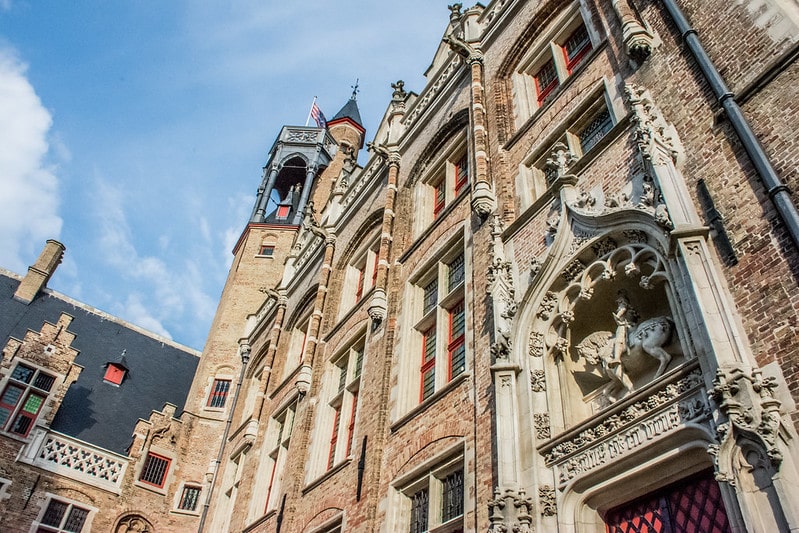 Façade of the Gruuthuse Museum
Façade of the Gruuthuse Museum© Sarah Bauwens
Stepping into the majestic entrance hall of the Gruuthuse Palace is like stepping into the rich, late Middle Ages when the Count of Flanders had a monopoly on the sale of grute, a dried herb mixture that was added to beer. From the twelfth century onwards, ‘grute-right’ was bestowed in a loan on a knightly family in Bruges.
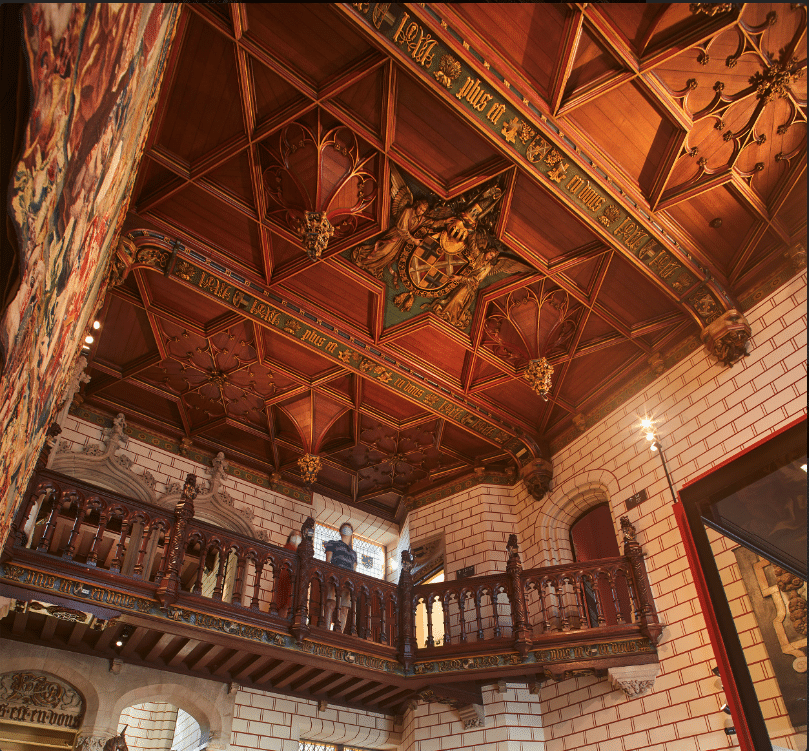 The majestic entrance hall of the Gruuthuse Museum
The majestic entrance hall of the Gruuthuse Museum© Kris Vandevorst
In time these families were called the Lords of Gruuthuse and their most famous descendent was Louis (ca. 1422-1492). Louis was the embodiment of the family slogan. The 15th-century motivational quote exhorting everyone to get the best out of themselves is repeatedly found on crossbeams and tiles, on shields and manuscripts throughout the museum. This confirmation of his faith in his own abilities provided Gruuthuse with his entrée into the aristocratic society surrounding Philip the Good (1396-1467).
 Louis of Gruuthuse (ca. 1422-1492)
Louis of Gruuthuse (ca. 1422-1492)© Wikipedia
As a top advisor, Louis also carried out diplomatic missions for the successive duke Charles the Bold, as well as the Duchess, Mary of Burgundy. After a military campaign near Bordeaux (1492), where he commanded the ducal troops, and where some rather lethal devices were first used, he proudly had illustrations of fire-breathing artillery added to the illuminated manuscripts that accompanied his coat of arms. Small replicas of the devices adorn the handrail in the tiled staircase hall.
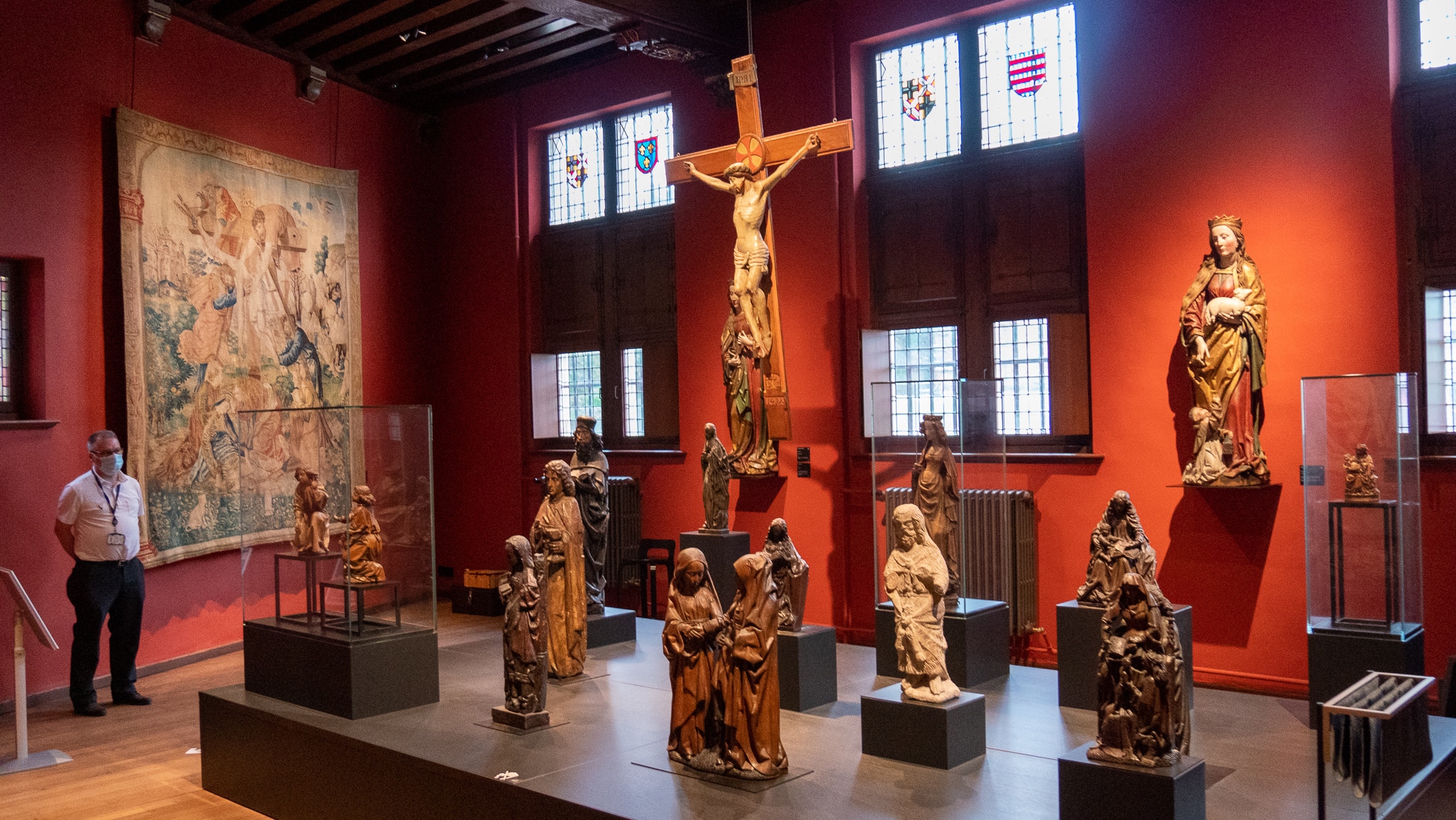
© Tom Christiaens
Thanks to trade through the natural harbour of the Zwin, Bruges was one of the richest cities in Western Europe during the remarkable transition period between the Middle Ages and modern times and the Burgundians did not hesitate to flaunt their wealth and power through fabulous spectacles, parties and tournaments. Naturally, the churches, monasteries and successful citizens of Bruges, including the Lords of Gruuthuse, emulated them by installing splendid luxury products and utensils in their interiors. The stained-glass windows, tapestries, paintings, furniture, … but also refined jewellery and medieval toys bear witness to the city’s strong attraction for craftsmen and artists.
Thanks to trade Bruges was one of the richest cities in Western Europe during the remarkable transition period between the Middle Ages and modern times
Louis’ prestige is even more apparent in his magnificent library comprising 162 manuscripts. Only Duke Philip the Good himself was a more ardent bibliophile. The most famous piece in the collection is undoubtedly the Gruuthuse manuscript, which bears Louis’ name and contains the immortal lamentation Egidius, waer bestu bleven? (Egidius, where have you been?) Although the manuscript no longer resides in Bruges, its spirit still lives on here.
At the museum today, the many spiral staircases make access difficult for wheelchair users, but the award-winning new approach does pay attention to all the senses, for instance, by offering tactile models for people with visual impairments. Appropriate multimedia devices enrich the story, providing information sheets for those who want more information about a specific case, piece of cutlery, carving or lace vest but prefer to avoid a deluge of information panels or touch screens. In this way, the interior has retained something of its domestic feel and still exudes the atmosphere of this sumptuous 15th-century household.
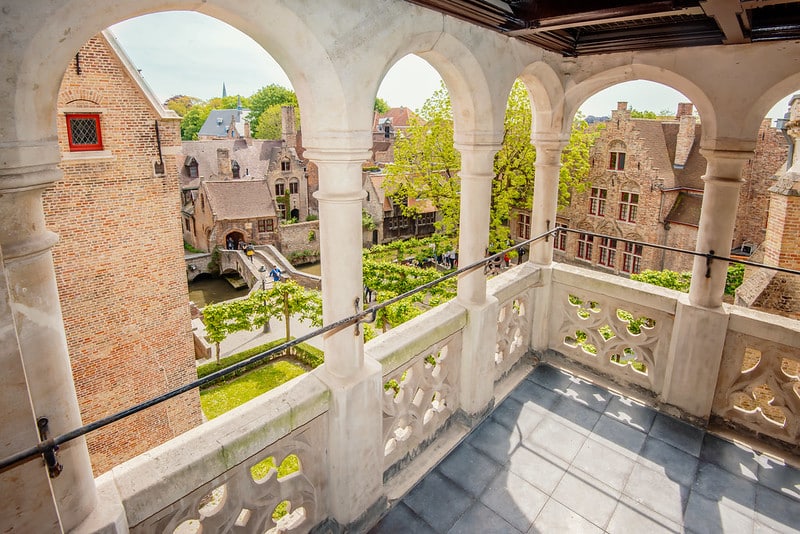 The balcony of the Gruuthuse Museum offers one of the most beautiful views of Bruges.
The balcony of the Gruuthuse Museum offers one of the most beautiful views of Bruges.© Inge Kinnet / Musea Brugge
The wealthy Gruuthuse family had a window on the world – literally, considering that there is a balcony offering one of the most beautiful views of Bruges – and inhabited it as citizens of this ideal city just as the Humanists dreamed they should. One of the highlights is the beautiful wooden oratory that connects the family’s private rooms directly with the choir of the Church of Our Lady, where the tombs of Charles the Bold and Mary of Burgundy still attract visitors.
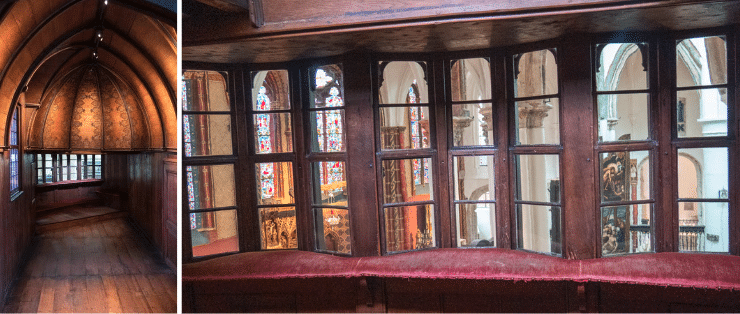 A wooden oratory connects the family’s private rooms directly with the choir of the Church of Our Lady,
A wooden oratory connects the family’s private rooms directly with the choir of the Church of Our Lady,© Tom Christiaens
After 1480, Bruges lost its position as a leading trading metropolis to Antwerp due to both religious disputes and the silting up of the Zwin. In 1596, the Gruuthuse Palace became the property of the Spanish King, Philip II. Later, a branch of the Mountain of Mercy, a pawnshop for the poor, was housed in it but nothing of that period is documented in the museum except for a stone wall plaque.
Another exhibit illustrates how the people of Bruges were so successful in the 17th and 18th centuries thanks to the digging of canals and the influence of a strong Chamber of Commerce, which provided a turning basin in the city’s port. The discovery of the New World brought previously unknown and exotic products to the market, such as chocolate, coffee and tobacco. Visitors can admire the beautifully decorated silver pitchers and platters and smell the luxury products. Maps and engravings clearly show that trade agreements and a globalised market had been established for centuries. The maps also provide evidence of the more exotic influences in Bruges through place names such as Spaans loskaai (Spanish Dock) or Oosterlingenplein (Square of the peoples of the Far East).
The people of Bruges were successful in the 17th and 18th centuries thanks to the digging of canals and the influence of a strong Chamber of Commerce
About 200 years ago, tourists began to discover the charm of Bruges as a romantic destination, starting with English soldiers on their way back from Waterloo, or so the story goes. In any case, the 19th century saw a new wave of respect for high-quality medieval craftsmanship. This nostalgia resulted in the neo-Gothic movement. A video clearly tells how the city of Bruges bought the Gruuthuse Palace in the mid-19th century to turn it into a museum. City architect and neo-gothic adept Louis Delacenserie worked on the renovation for years, adding numerous medieval elements. The most recent renovation was carried out with attention to the layers of Delacenserie’s work.
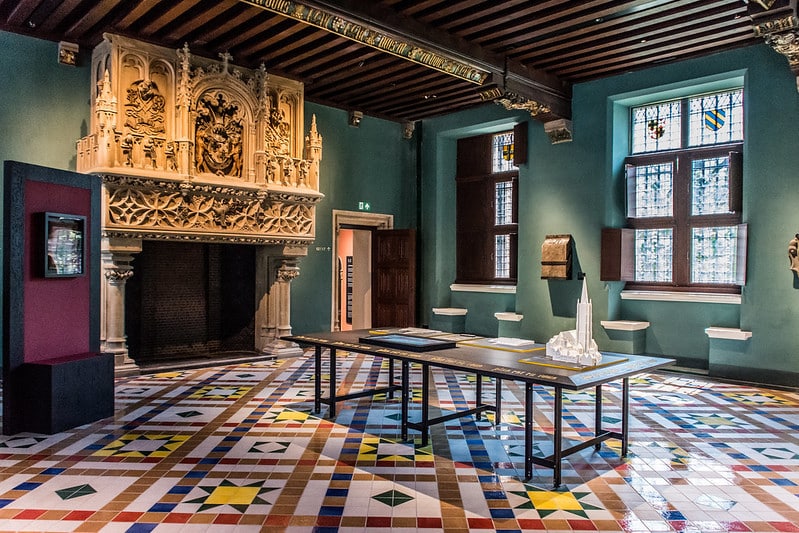
© Sarah Bauwens
Due to the 17th-century renovations and the 19th-century adjustments to what was previously a museum of antiquities and lace, not much of the ground floor of the museum we visit today is original, but only a trained eye can distinguish the neo-gothic from the medieval. Many 15th-century elements have been preserved, while others have been reconstructed in a contemporary manner in the most recent restoration. For example, the hand-painted ‘brick’ wall in the entrance hall provides a historical and, at the same time, somewhat playful effect.
There has been a lot of discussion about the authenticity of medieval Bruges and the neo-Gothic touristic ‘kitsch’ or the romantic fondness for the rich medieval past. A visit to the Gruuthuse Museum immerses visitors in that past but also exposed them to the contradictions, allowing them to experience how heritage and historical appreciation change over time and always create a construction that says something about the present. More than just a tourist attraction with old showpieces from the past, the new Gruuthuse Museum also looks to the future. A climb all the way up in the attic leads to Studio+ and spectacular views of the city. Under the massive beams, young people can work on the art of the future in a participatory process that visualises the historical collection with contemporary eyes.
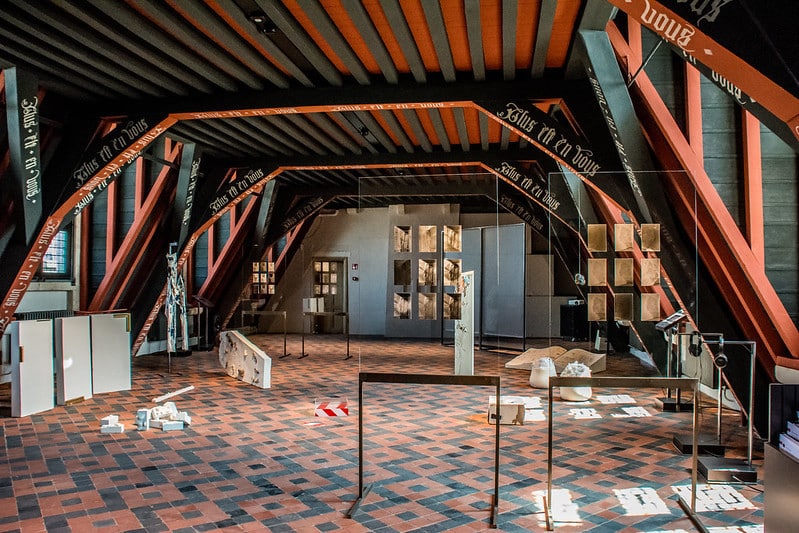 Contemporary art is often shown in the museum's attic.
Contemporary art is often shown in the museum's attic.© Sarah Bauwens / Musea Brugge
The variety inherent in the collection, the arrangements, the beautiful light and the sense of discovery on the different floors along the spiral staircase ensure that this museum is more than just a dull display of dead objects. After the visit, after heading out again into the bright sunlight, children sit near the well in the courtyard, drawing the facade. The sounds of modern Bruges resound over the cobblestones, mixed with the languages of the tourists. Here, it really is possible that a person could become motivated by the plus est en vous in his own life.












